Sights of Smolensk
Around Ploschad Lenina and the City Gardens

'In the World of Fairy Tales' Museum
- 15 Ulitsa Lenina
- http://www.smolensk-museum.ru
- 10:00 - 18:00 (Friday: 10:00 - 17:00). Closed on Mondays.
As its name suggest the 'In the World of Fairy Tales' Museum is especially for children. Inside the museum has recreated scenes from Russian folk tales and the stories of Aleksandr Pushkin. Children can even come face to face with Baba Yaga and Leshi. Also on display are children’s artwork inspired by a visit to the museum. The museum is run as part of the Smolensk State Museum-Reserve. Read more »
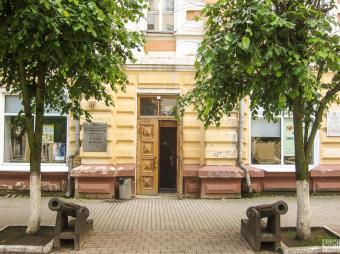
History Museum and Nature and Ecology Museum
- 8 Ulitsa Lenina
- http://www.smolensk-museum.ru
- 10:00 - 18:00 (Friday: 10:00 - 17:00). Closed on Mondays.
Smolensk's History Museum is the oldest museum in the city and dates from 1888 when an archaeological museum was established in the building of the city duma. Today the museum details the history of the city which stretches back over 1000 years. Located in the same building is the Nature and Ecology Museum. Its main exhibition recreates scenes of the flora and fauna found in the Smolensk Region, but also details man's detrimental impact on nature. The museums are run as part of the… Read more »
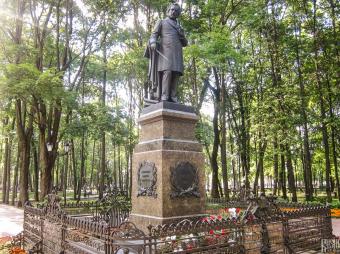
Mikhail Glinka City Gardens
- Mikhail Glinka City Gardens
Smolensk's pleasant city gardens are known as the Mikhail Glinka City Gardens and opposite the Smolensk Philharmonic is a monument to the great Russian composer himself, who was born and grew up in the village of Novospasskoe in the Smolensk Governorate. This monument to him was unveiled in 1885. A lovely feature is the surrounding fencing which is decorated with the scores of some of Glinka's work. Deer Sculpture In the north western corner of the gardens is another sculpture … Read more »
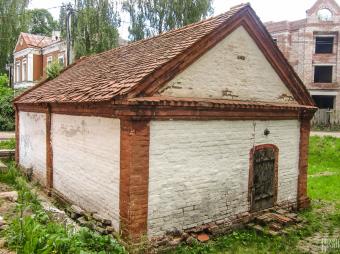
Museum of a 12th Century City Blacksmith
- 10A Ulitsa Lenina
- http://www.smolensk-museum.ru
- 10:00 - 18:00 (Friday: 10:00 - 17:00). Closed on Mondays.
This museum is housed in the oldest civilian building in Smolensk. It was built in the mid-17th century and by the 18th century it was being used as a blacksmith’s workshop, to which the museum located there is now dedicated. On display in the museum you will find the tools of the trade and many items made by the blacksmith, including keys, locks, weapons and utensils. The museum is run as part of the Smolensk State Museum-Reserve. Read more »
Resurrection of Christ Church (Planetarium)
- 9 Ulitsa Voykova
The Resurrection of Christ Church was completed in 1765 using the funds of a local merchant. The baroque style church comprises a cube structure with two levels of windows and topped with a single dome. Attached to this via a vestibule is a small bell tower. The church was closed in the Soviet period and converted into a planetarium. Read more »
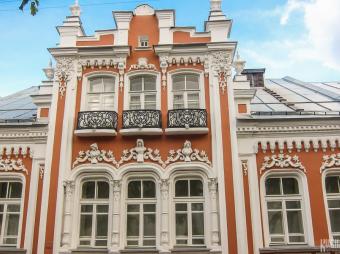
Sergei Konyokov Sculpture Museum
- 7 Ulitsa Mayakovskogo
- http://www.smolensk-museum.ru
- 10:00 - 18:00 (Friday: 10:00 - 17:00). Closed on Mondays.
This museum is dedicated to the work of the famous sculptor who was born in 1874 in the Smolensk Governorate and later won both the Lenin and Stalin Prizes. Konyokov died in 1971 and this museum was opened in his memory two years later. Upon its opening works from his Moscow workshop were transferred here and put on display. Many of his sculptures are made out of wood including some examples incorporating scrap pieces of wood. The museum is run as part of the Smolensk State Museum… Read more »
Smolensk Art Gallery
- 4 Ulitsa Kommunisticheskaya
- http://www.smolensk-museum.ru
- 10:00 - 18:00 (Thursdays: 11:00 - 19:00; Fridays: 10:00 - 17:00). Closed on Mondays and the last Tuesday of the month.
The Smolensk Art Gallery is housed in a pretty pink building which dates from 1905. The basis of the gallery’s collection is made up of Russian works of art by some of Russia's greatest artists. Also on display are ancient Russian icons from the Moscow, Pskov and Novgorod schools and wooden sculptures from the 15th to 18th centuries. The gallery is run as part of the Smolensk State Museum-Reserve. Read more »
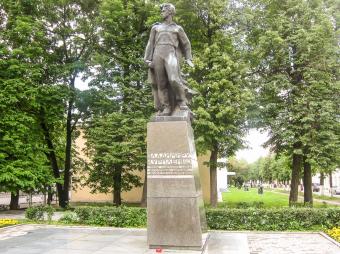
Vladimir Kurilenko Monument
- intersection of Ulitsa Kommunisticheskaya and Ulitsa Mayakovskogo
This monument is dedicated to Vladimir Kurilenko who was a member of a partisan-sabotage squad active in the occupied Smolensk Region during the Second World War. Kurilenko had great success in harassing the occupiers by blowing up bridges and equipment and killing enemy soldiers. He was eventually wounded in May 1942 and died of his injuries aged just 17. After his death he was awarded the title of Hero of the Soviet Union for his bravery and for the example he set for carrying… Read more »
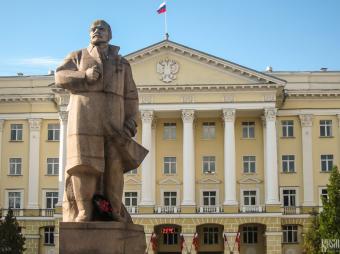
Vladimir Lenin Monument
- Ploschad Lenina
Smolensk's impressive Lenin Monument stands on Ploschad Lenina (Lenin Square) and is complemented by the pretty House of Soviets, which is now the regional administration, behind it. The statue was unveiled in 1967 and stands at nine metres tall in total. It is made out of red granite blocks and depicts Lenin standing on a pedestal wearing a coat blowing against the wind. Read more »
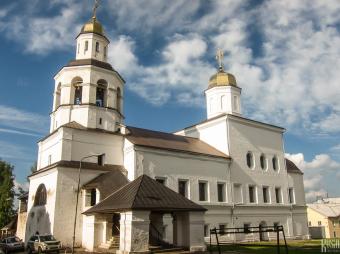
Voznesensky Convent
- 9 Ulitsa Konyonkova
The Voznesensky Convent was established in the 1630s and dedicated to the Ascension ('voznesenie') of Christ. In 1665 the monastery was changed into a convent. Closed during the Soviet times, the convent has since been reopened. The convent's main cathedral is the large Ascension Cathedral which was built between 1693 and 1704 on the orders of Tsar Peter the Great, who decided to replace the convent's old wooden churches. Two other churches are found inside: the 18th century… Read more »
Around Ploschad Pobedy and Ulitsa Tenishevoi
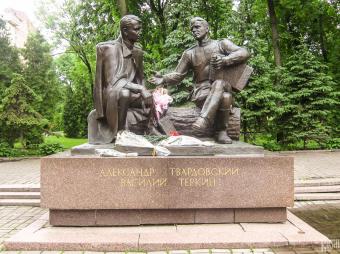
Aleksandr Tvardovsky and Vasili Tyorkin Monument
- Ploschad Pobedy
On Ploschad Pobedy there is a monument depicting the poet Aleksandr Tvardovsky sat on a bench conversing with his most famous character Vasili Tyorkin. The poem featuring Vasili Tyorkin as a soldier in the Second World War was published and became popular during the war. The monument was unveiled in 1995 as part of the 50th anniversary of the end of the Second World War. Read more »
Aleksandr Tvardovsky Apartment-Museum
- apartment 26, 4 Zapolny Pereulok
- http://www.smolensk-museum.ru
- 10:00 - 18:00 (Fridays: 10:00 - 17:00). Closed on Mondays.
This apartment-museum was opened in 1990 and is dedicated to the Soviet writer and poet Aleksandr Tvardovsky. It is located in the apartment where Tvardovsky lived from 1943 to 1944 during his time in Smolensk as a war correspondent. The apartment’s 1950s interior has been preserved and information on Tvardovsky’s life and work is displayed. The museum is run as part of the Smolensk State Museum-Reserve. Read more »
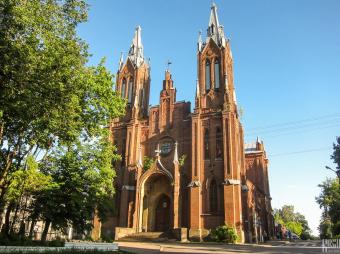
Immaculate Conception of Virgin Mary Roman Catholic Church
- 10 Ulitsa Ugritskogo
The impressive Immaculate Conception of Virgin Mary Roman Catholic Church was built between 1884 and 1896 in the gothic revival style. After the revolution the church was closed and turned into an archive, with shelves reaching to the very top of the church. During the conversion the church's organ was destroyed. Since 2010 there have been plans to move the archive, restore the building and return it to the Catholic Church. Read more »

Mikhail Mikeshin Monument
- next to 7 Ulitsa Tenishevoi
This monument is dedicated to the renowned Russian sculptor Mikhail Mikeshin who was born in 1835 in the village of Maksimkovo in what was then the Smolensk Governorate. Mikeshin's most famous work is undoubtedly the spectacular Millennium of Russia Monument Bell in Novgorod Veliky. This monument of him was unveiled in 1985 on the 150th anniversary of his birth and depicts Mikeshin working on his masterpiece. Read more »
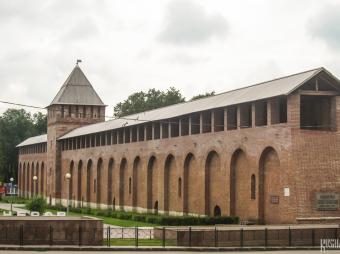
Mokhovaya Tower
- Park Pionerov and Ploschad Pobedy
The Mokhovaya Tower stands on its own with only two small sections of walls on either side between Park Pionerov (Pioneer Park) and Ploschad Pobedy (Victory Square). During the Nazi occupation of Smolensk many Soviet citizens were lined up against this part of the wall and executed. A mass grave is now located next to the wall on the Pioneer Park side. On the other side of the wall there are metal plaques detailing the events of the Second World War. Read more »
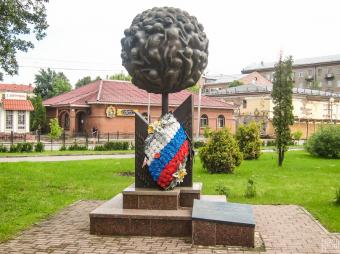
Scorched Flower Sculpture
- Park Pionerov
The haunting Scorched Flower Sculpture was unveiled in 2005 in Park Pionerov (Pioneer Park) on the 60th anniversary of the end of the Second World War. It is dedicated to the child victims of Nazi concentration camps. The head of the flower is covered with engravings of children's bodies and the flower's leaves comprise plinths with the names of concentration camps. Read more »
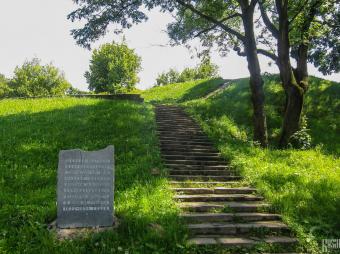
Shein Bastion
- Park Pionerov
This 18 metre high earthen mound was built in 1634 to cover the gap left after the Granovitaya Tower and surrounding walls had been destroyed. It is now named after Mikhail Shein who commanded Russian troops during the 1609-1611 Siege of Smolensk and the Smolensk War of 1632-1634. During the Napoleonic Wall the bastion was reinforced and saw heavy fighting once again. Read more »
Smolensk Flax Museum
- 7 Ulitsa Tenishevoi
- http://www.smolensk-museum.ru
- 10:00 - 18:00 (Fridays: 10:00 - 17:00). Closed on Mondays.
The people of Smolensk have been involved in the flax trade for centuries, firstly spinning it by hand, then using spinning wheels and then using modern automated machines. This museum was opened in 1980 and tells the history of the production of flax in the Smolensk and displays original tools of the trade. Traditional flax products can also be purchased at the museum. The museum is run as part of the Smolensk State Museum-Reserve. Read more »
Around Sobornaya Gora
Annunciation Church
- Soborny Dvor, Ulitsa Sobornaya Gora
The Annunciation Church is located on the northern slope of Sobornaya Gora. It was built in 1773 in the baroque style, comprising the main cube structure of the building, a vestibule and originally a bell tower. The church was so heavily damaged in the Second World War that the bell tower had to be demolished in 1952. The church was restored in 1980 and the church's dome was replaced. Read more »
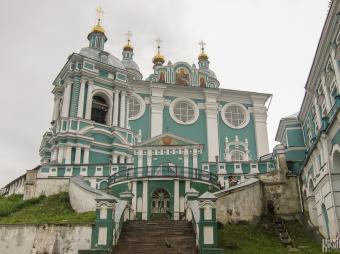
Dormition Eparchial Cathedral
- Soborny Dvor, Ulitsa Sobornaya Gora
Located on the top of Sobornaya Gora is the beautiful Dormition Cathedral which is the eparchial cathedral of the Smolensk and Vyzama Eparchy. The construction of the original version of the cathedral was started in 1101 by Prince Vladimir Monomakh and completed by Prince Rostislav Mstistlavich of Smolensk in 1150. During the Time of Troubles and the siege of Smolensk, the cathedral was blown up with civilians inside; it is not known whether this was a deliberate case of mass… Read more »

Epiphany Cathedral
- Soborny Dvor, Ulitsa Sobornaya Gora
Immediately next to the Dormition Cathedral is the Epiphany Cathedral. It was built between 1782 and 1787 to replace an earlier wooden version and to serve as a winter (ie heated) church for the summer Dormition Cathedral. The Epiphany Cathedral is decorated in the same colour as its much larger neighbour creating a harmonious church ensemble. Read more »
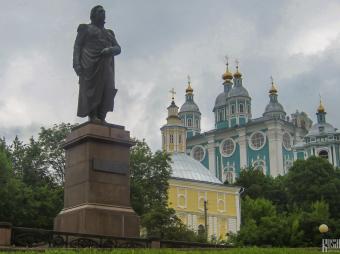
Mikhail Kutuzov Monument
- Ulitsa Sobornaya Gora
Located at the foot of Sobornaya Gora is a monument to Mikhail Kutozov, which was unveiled in 1954 and depicts the Russian general during the Napoleonic War in full height standing on a pink granite pedestal. For his achievements during the war against Napoleon, Kutozov was named general-field marshal and Prince ('Knyaz') of Smolensk. Read more »
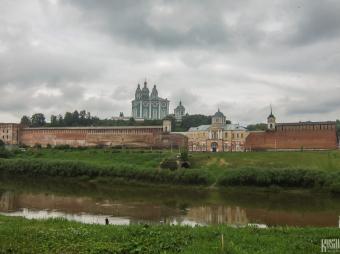
Our Lady of Smolensk Church and Volkova Tower
- 1 Ulitsa Soboleva
In 1729 the Frolyovskaya Tower of the kremlin walls was demolished as it had been ruined over the course of Russia's wars with Poland. In its place a wooden church was built and then, when that became dilapidated, the Dneprovskie Gates were built which incorporated a church. The gates was then damaged in 1812 by French troops but rebuilt in 1814. The church was closed by the Soviets in 1928. The upper storey of the church was damaged in the Second World War and as the bridge… Read more »
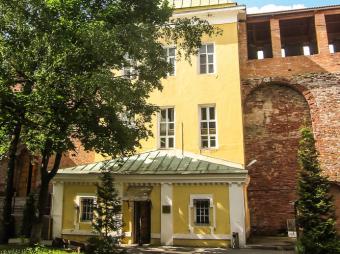
Pyatnitskie Gates (Museum of Russian Vodka)
- 4 Ulitsa Studencheskaya
- 09:00 - 17:00. Closed on Sundays.
In 1812 the French destroyed what were the Pyatnitskie Gates in the kremlin walls. In 1815 it was decided to build a church in the gap and St Tikhon of Zadonsk's Church was completed in 1816. Originally the church was used as a prison church for the prison which was located nearby. St Tikhon of Zadonsk's Church was closed in the Soviet times and it now holds a small museum dedicated to Russian vodka and a restaurant. Read more »
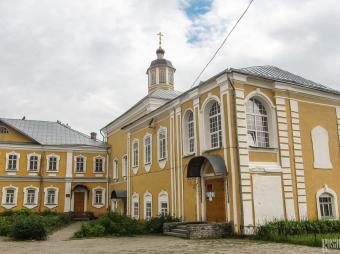
St John the Baptist's Church
- Soborny Dvor, Ulitsa Sobornaya Gora
Also situated on Sobornaya Gora is St John the Baptist's Church. The church's original cube structure topped with a single dome was built in 1703. Later another building was added onto this to hold a sacristy. In the late 18th century the original part was reconstructed and at the same time another building was added to hold a refectory. Read more »
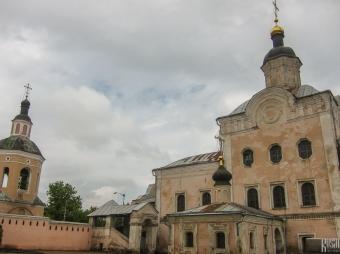
Troitsky Monastery
- 9 Ulitsa Bolshaya Sovetskaya
The Troitsky Monastery was consecrated in 1699 and was the residence of the bishops of Smolensk up to 1703. Its main cathedral is the Trinity Cathedral which was built between 1672 and 1727 and is baroque in style with two stories. Also inside the monastery is the smaller Conception of Anna Church which dates from 1767. Located on the other side of the road to the monastery is the monastery's bell tower. Read more »
Around Ulitsa Dzerzhinskogo
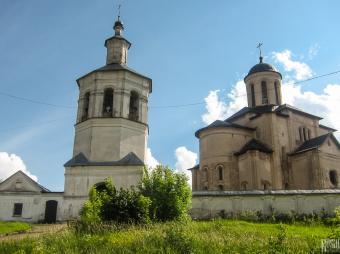
Archangel Michael's Church (Svirskaya Church)
- between Ulitsa Parkovaya and Ulitsa Malokrasnoflotskaya
Archangel Michael's Church is also known as Svirskaya Church as it once had an altar dedicated to St Alexander of Svirka. It is one of Smolensk's three churches which date from the pre-Mongol era, having been built during the reign of Prince Davyd Rostislavich of Smolensk sometime between 1180 and 1197. Prince Davyd was later interred here but the crypt holding his remains has not survived. During the Polish occupation of Smolensk it was used as a Catholic church. Reconstruction… Read more »
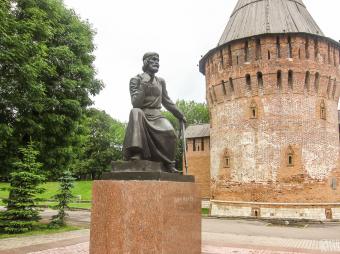
Fyodor Kon Monument
- intersection of Ulitsa Dzerzhinskogo and Ulitsa Oktyabrskoy Revolyutsi
Fyodor Kon was a 16th century architect whose work includes the walls and towers of Moscow's Bely Gorod and the Smolensk Kremlin, hence this monument in the city. The monument is by the renowned sculptor Oleg Komov and was unveiled in 1991. The monument is located close to the Gromovaya Tower - a fine example of Kon's work. Read more »
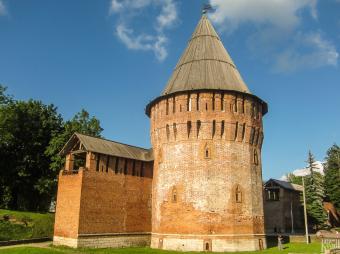
Gromovaya Tower (Smolensk - Shield of Russia Museum)
- 3 Ulitsa Oktyabrskoi Revolyutsi
- http://www.smolensk-museum.ru
- 10:00 - 17:00 (Friday: 10:00 - 16:00). Closed on Mondays.
The round Gromovaya (Thunder) Tower with its pretty wooden roof stands alone and houses the 'Smolensk - Shield of Russia' Museum which has exhibits on Smolensk's military past. The second tier of the tower has displays on the building of the Smolensk Cathedral. The third tier has an exhibit on the Battle of Grunwald, where soldiers from Smolensk took part in the Grand Duchy of Lithuania's defeat of the Teutonic Knights. The fourth tier comprises a viewing platform. The museum is… Read more »
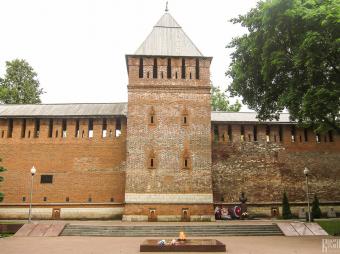
Heroes Remembrance Gardens
- Skver Pamyati Geroev
The gardens between Ulitsa Dzerzhinskogo and the section of kremlin walls are known as Skver Pamyati Geroev (Heroes Remembrance Gardens). The gardens were first developed as 1812 Remembrance Square in 1912 to mark the centenary of Russia's Patriotic War of 1812 against Napoleon. As part of this a bust of Kutuzov and the City Academy were opened on the square. After the Second World War the area was renamed the Heroes Remembrance Gardens as it also became a site of remembrance of… Read more »
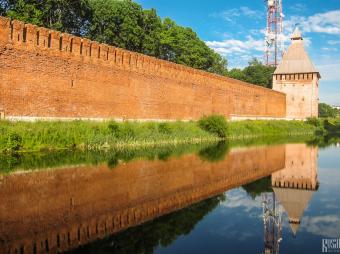
Kopytenskie Gates and Bubleika Tower
- along Skver imena Pushkina
The most western stretch of the kremlin walls includes the Bubleika Tower and the Kopytenskie Gates, both of which are square in structure with wooden roofs. The Bubleika Tower takes its name from the Russian word for tambourine (buben) as percussion instruments were installed here to be beaten upon the sighting of approaching enemies. Running along this stretch of wall is part of a moat. Read more »
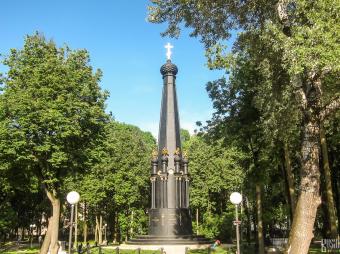
Lopatinsky Gardens
- Lopatinsky Sad, off Ulitsa Karla Marksa
At the spot where the walls from the Kopytenskaya Tower end are the Lopatinsky Gardens (also known as the Central Park of Culture and Rest) where another of Smolensk's symbols is located - the Monument to the Defenders of Smolensk on the 4th and 5th August 1812. It was unveiled in 1841 on the 29th anniversary of the liberation of Smolensk from Napoleon's forces. It comprises a 26 metre cast iron octagonal obelisk which is topped with a dome and a golden cross. The obelisk is also… Read more »
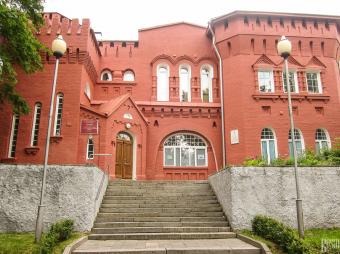
Museum of Smolensk Lands during the Second World War
- 4A Ulitsa Dzerzhinskogo (Skver Pamyati Geroev)
- http://www.smolensk-museum.ru
- 10:00 - 18:00 (Fridays: 10:00 - 17:00). Closed on Mondays.
Built in a gap in the kremlin walls, which start with the reconstructed Kassandalovskaya Tower, is what was once the City Academy and now Smolensk's most popular museum - the Museum of Smolensk Lands during the Second World War. Smolensk played an important role during the Second World War and this museum details the first months of the war, the occupation, partisan activity, the liberation and then the role of soldiers from Smolensk in the liberation of Eastern Europe. The museum… Read more »
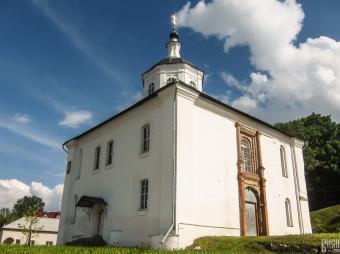
St John the Theologian's Church
- 1 Ulitsa Dzerzhinskogo
St John the Theologian's Church is one of Smolensk's three churches which date from before the Mongol era, having been built around 1173 during the reign of Prince Roman Rostislavich of Smolensk. In form it is a single dome four-pillar cube structure. The church was heavily damaged during the Time of Troubles and was turned into a Catholic church for all of the subsequent Polish occupation of Smolensk. The church also suffered at the hands of the French in 1812. In 1933 the church… Read more »
Around Ulitsa Timiryazeva and Ulitsa Zhukova
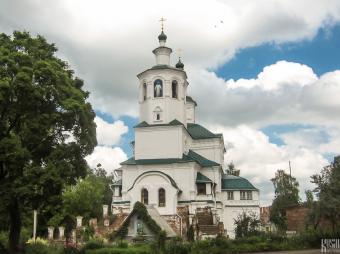
Avraamiev Monastery
- 20 Ulitsa Krasnogvardeyskaya
Located against the kremlin's eastern wall is the Avraamiev Monastery which is the oldest monastery in the city having been founded in the beginning of the 13th century. During the siege of the city in 1609-1611, the monastery was damaged and turned into a Catholic monastery. It only became an Orthodox monastery once again 1654 after the Russians retook the city. In 1917 the monastery was closed and only reopened in 2002. Inside is the baroque Transfiguration of the Saviour… Read more »

Eastern Section of Walls
- along Ulitsa Timiryazeva, Ulitsa Marshala Zhukova and Ulitsa Isakovskogo
By far the largest section of the kremlin to survive is the eastern section which includes nine towers (Veselukha Tower, Pozdnyakova Tower, Oryol Tower, the Avraamievskie Gates, Zaaltarnaya Tower, Voronina Tower, Dolgochyovskaya Tower, Zimbulka Tower and the Nikolskie Gates) each connected to each other with walls. The towers alternate from round ones to square ones. The most iconic is probably the round Oryol (eagle) Tower. The section ends with Nikolskaya Tower which also… Read more »
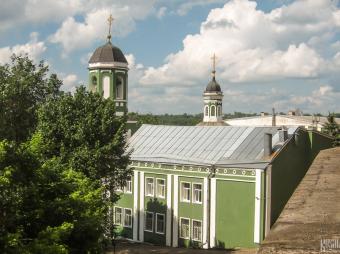
Intercession Church
- 5 Ulitsa Timiryazeva
Standing on a hill right up against the kremlin wall is the Intercession Church. It was built between 1789 and 1799 using the funds of a local priest to replace an earlier wooden version. Later a two storey building in the classical style was built onto the original part of the church which is now used to house a spiritual academy. Read more »
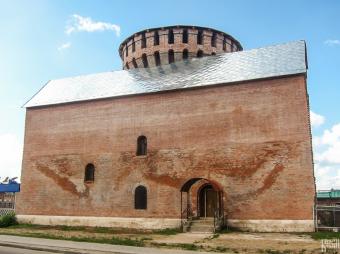
Kostyrevskaya Tower
- 5 Ulitsa Soboleva
The Kostyrevskaya Tower dates from 1837 when it was built on the orders of Emperor Nicholas I in the style of the original tower of the Smolensk Kremlin, although to a slightly smaller scale. The original tower itself was demolished in 1833 due to its dilapidated condition. Other names include the Krasnaya, Kruglaya, Porokhovaya, Rachevskaya and Cherepakhovaya Tower. Read more »
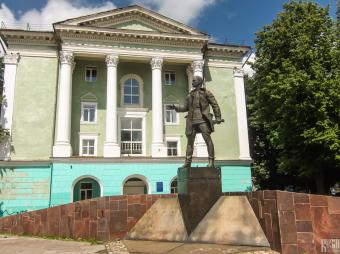
Nikolai Krylenko Monument
- outside 21 Ulitsa Kommunisticheskaya
Nikolai Krylenko was born in 1885 in the Smolensk Governorate and went on to become a leading Bolshevik revolutionary and Soviet politician, serving in various posts such as head of the Russian Army, People's Commissar for Justice and the Prosecutor General. As Prosecutor General he oversaw several high-profile show trials. However Krylenko would himself meet his end in 1938 when he was arrested. He "confessed" to his crimes under torture but later retracted these in his trial… Read more »
St George's Church
- 33A Ulitsa Furmanova
St George's Church was built in 1782 and in structure it represents a 'octagon-on-cube' style church. The main structure is pink in colour and decorated with pilasters. It has three levels of windows each decorated with carved window frames. In 1826 a small two-tier bell tower was built onto the church. Read more »
Transfiguration of the Saviour Church
- Ulitsa Revvoencoveta
The large Transfiguration of the Saviour Church was built between 1766 and 1768. The main part of its building represents a tall two-storey structure topped with a dome on an octagonal tholobate. Built onto this is a two-storey vestibule and then a bell tower, which now has a very cubic appearance as the top of the bell tower has been lost. Read more »
Gnyozdovo
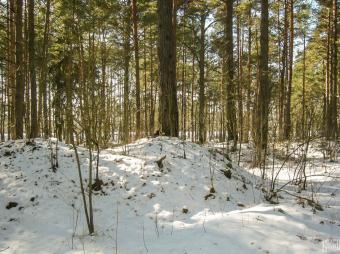
Gnyozdovo Archaeological Complex
- Vitebskoe Shosse, near Gnyozdovo (approximately 12km from Smolensk)
- http://gnezdovo-museum.ru/
The Gnyozdovo Archaelogical Complex is one of the most significant archaeological sites for a Viking-era settlement. There is evidence that an important 10th century hill fort (gorodische) and settlement once existed here on "the route from the Varangians to the Greeks" (ie from Scandinavia to Byzantium). The site was first discovered by chance in 1867 when workmen involved in the construction of the new railway line discovered 10th century jewellery. Since then many other valuable… Read more »
Katyn
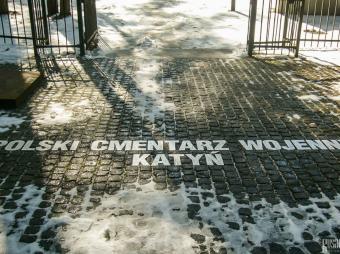
Katyn Memorial Complex
- Katyn
In 2008 the Katyn Memorial Complex was opened at the site where in 1940 the NKVD murdered 4,241 Polish officers who were taken prisoner when the Soviet Union invaded Poland. Originally the Nazis were blamed for the crimes and only in 1990 did the USSR admit that the NKVD was responsible. The site has become a national place of pilgrimage for many Polish people, even more so after the plane carrying Poland's delegation to the Katyn anniversary event crashed nearby in 2010 leaving… Read more »
North of the River Dnieper
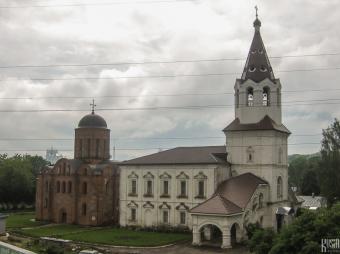
Church Ensemble at Kashena
- 20 Ulitsa Kashena
Located on Ulitsa Kashena, next to the railway station, is a church ensemble comprising two churches, which includes one of Smolensk's three churches from before the Mongol era - Ss Peter and Paul's Church. Ss Peter and Paul's Church This church dates from 1146 when it was founded by Prince Rostislav Mstislavich of Smolensk and consecrated by Bishop Simeon, the first bishop of Smolensk. However it has suffered greatly over the years and has been restored several times. During… Read more »
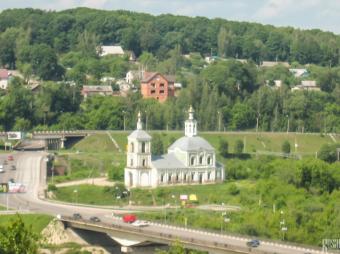
St George's Upper Church
- 2 Ulitsa Tolmacheva
St George's Upper Church is so-called to distinguish it from the St George's Church south of the River Dnieper. It was completed in 1810 and sacked two years later during the French occupation of Smolensk. It was restored in 1820 and later became a cemetery church. During the Soviet times it was allowed to fall into disrepair and was practically in ruins when it was returned to the Orthodox Church in 1993. It has since been restored and reopened. Read more »

St Nicholas' Church and Chapel
- 4A Ulita Belyaeva
St Nicholas’ Church was built in 1748 and is a pretty two storey church painted red with green roofing. The upper storey is dedicated to St Nicholas and the lower story to the Our Lady of Tikhvin Icon and St Mercurius of Smolensk. In 1812 the church was heavily damaged and restored in 1813 using money from the federal budget; a bell tower was also built. In 1927 the church was closed by the Soviets. It was only returned to the Orthodox Church in 1996 and restoration work was… Read more »
Talashkino / Flenovo
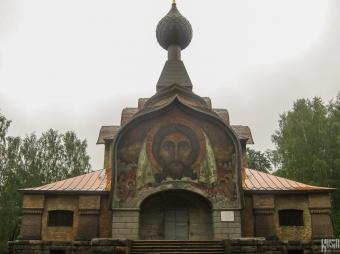
Talashkino Estate
- village of Flenovo
- http://www.smolensk-museum.ru/catalog/teremok/
- 10:00 - 18:00. Closed on Mondays.
Located just outside the village of Talashkino in the village of Flenovo is the Talashkino Estate which is now run as the 'Teremok' Historic and Architectural Complex - a branch of the Smolensk State Museum-Reserve. In 1893 Knyaginya (princess) Maria Tenisheva bought the estate and invited her artistic friends, who included Ilya Repin, Sergey Malyutin, Nicholas Roerich, Mikhail Nesterov and Igor Stravinsky among others, to come and work on the estate. 'Teremok' House The estate… Read more »


 History
History